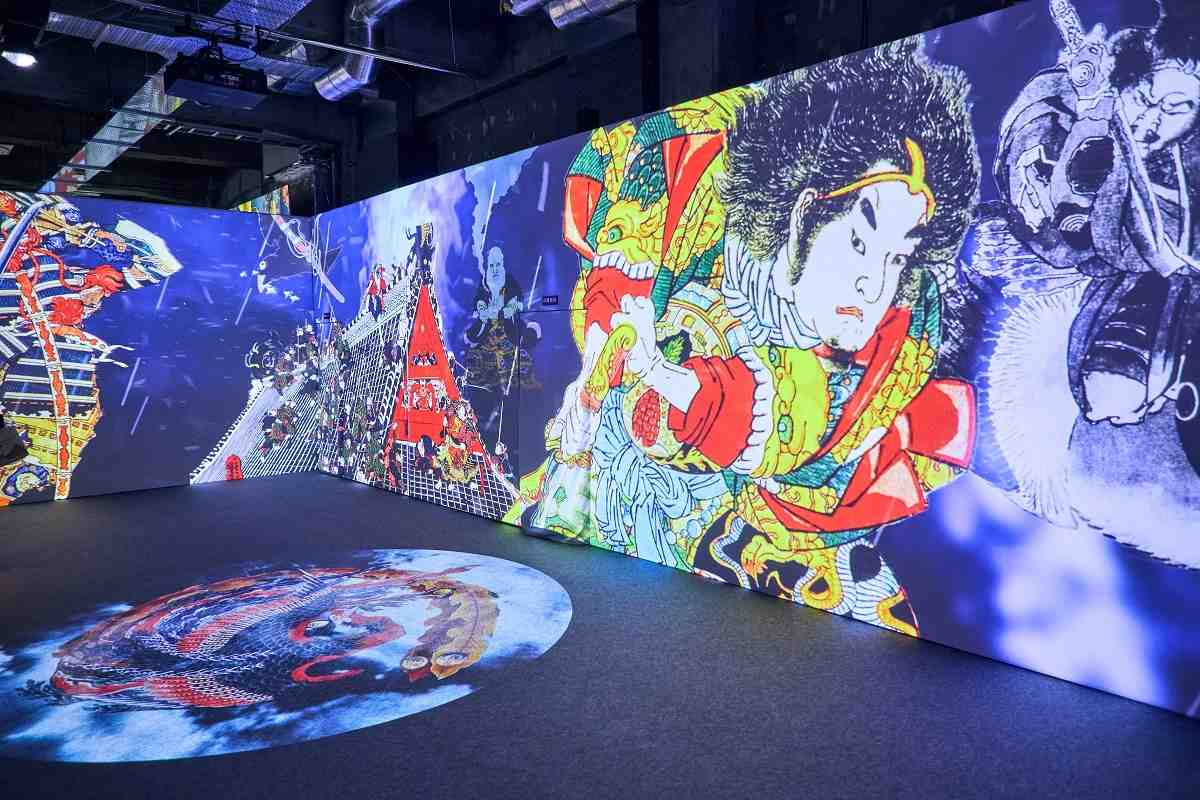
Patterns taken from ukiyo-e works are projected onto an object resembling Mount Fuji at the “Ukiyoe Immersive Art Exhibition” at Warehouse Terrada in Tokyo.
17:35 JST, December 28, 2024
TOKYO (Jiji Press) — A new art exhibition immersing visitors in the world of Japan’s “ukiyo-e” traditional woodblock print art through the latest digital technologies opened in Tokyo on Dec. 21.
“Ukiyoe Immersive Art Exhibition,” held at Warehouse Terrada in Shinagawa Ward, features works based on more than 300 ukiyo-e by renowned artists such as Katsushika Hokusai.
Visitors can walk through installations that use 3D computer graphic animation and projection mapping to bring figures, wildlife and scenery to life onto wall-sized screens and holographic displays. Descriptions of each piece are written in both Japanese and English, alongside replica prints of the ukiyo-e works used as inspiration.
Before arriving in Tokyo, the exhibition was previously staged in the cities of Nagoya and Kagoshima, as well as Milan.
Bringing ukiyo-e to mass audience


Left: Flowers drawn in the style of ukiyo-e fill the walls and floor of a room at the “Ukiyoe Immersive Art Exhibition” at Warehouse Terrada in Tokyo. Right: Warriors and other figures depicted in ukiyo-e works are shown in an installation themed on strength and power at the “Ukiyoe Immersive Art Exhibition” at Warehouse Terrada in Tokyo.
The exhibition comprises nine rooms, with many featuring images projected onto three walls and also the floor to give viewers the experience of stepping into the world of the art work.
Organizers said that the exhibition is designed to appeal to a broad audience by offering visitors various ways to enjoy ukiyo-e.
“Families of three, four generations can enjoy the exhibition,” said Takeaki Higashiyama, CEO of event production company Hitohata Inc., which is behind the exhibition. “Small children can enjoy the moving images, while elderly people who are not used to immersive [art exhibitions] can view [copies of the original works] at the back of the room and see how these are reflected in the installations.”
Such broad accessibility for ukiyo-e recalls the art form’s original role as a form of popular media in the Edo period (1603-1868). According to the event organizers, ukiyo-e was “a dominant form of popular culture” that was readily obtainable across the country in its heyday.
“Thanks to efforts like this, fans of ukiyo-e have grown from just core supporters to a wider range in the past few years,” Masumi Horiguchi, a television personality who is an ukiyo-e expert and adviser for the exhibition, said. “[The exhibition] is an easy-to-understand fun first experience with ukiyo-e for those in the modern age who are unfamiliar with the art form.”
Horiguchi added that the number of foreign fans especially is increasing, with ukiyo-e capturing a uniquely Japanese aesthetic that the country’s citizens often ignore but foreign people appreciate.
Digitizing ukiyo-e

An installation inspired by Katsushika Hokusai’s “The Great Wave off Kanagawa” is on display at the “Ukiyoe Immersive Art Exhibition” at Warehouse Terrada in Tokyo.
One of the installations in the exhibition is a room dedicated to the use of the color indigo in many ukiyo-e works. Also known as “Japan blue,” the distinct color is frequently used to depict the ocean and waves, such as in Hokusai’s “The Great Wave off Kanagawa.” Higashiyama said that bringing ukiyo-e works depicting the indigo sea and marine life onto screens was one of the biggest challenges in preparing the exhibition.
“Digital images are made with red, green and blue, the primary colors of light, so showing the indigo ink of actual ukiyo-e works was difficult,” he said.
The immersive experience required the event organizers to express what were flat ukiyo-e works in 3D computer graphics. For example, they created a 3D model of a colossal whale, modeled after the creature depicted in Utagawa Kuniyoshi’s ukiyo-e of the Edo-era swordsman Miyamoto Musashi slaying a whale. They then created footage to make it look as though the whale was swimming across the room, offering multiple perspectives.
“[Making ukiyo-e works move] involves separating the depicted subjects from their backgrounds,” Higashiyama explained. “The backgrounds behind the subjects are not drawn, so a designer who is a certified curator drew in such parts.”
Horiguchi said that such additions to ukiyo-e works require “immense respect for the artist,” and it is because such care is taken that the installations can be genuinely enjoyed.
"Culture" POPULAR ARTICLE
-

Van Cleef & Arpels Dazzles with Art Deco Artisanry at Tokyo Exhibit
-

Disney’s ‘Twisted-Wonderland’ Animated Series Puts Villains in Spotlight: New Show Features School Inspired by Classic Disney Films
-

Ayumi Hamasaki’s Shanghai Concert Canceled Day Before Schedule as Part of Beijing Backlash
-

‘The World Masterpiece Theater Series’ Celebrates 50 Years; Animator Looks Back on Creating Anime Classics
-

Popularity of Piggy Banks Across Time and Place Seen at Bank’s Museum of Money Boxes in Hyogo Pref.
JN ACCESS RANKING
-

Tokyo Economic Security Forum to Hold Inaugural Meeting Amid Tense Global Environment
-

Keidanren Chairman Yoshinobu Tsutsui Visits Kashiwazaki-Kariwa Nuclear Power Plant; Inspects New Emergency Safety System
-

Imports of Rare Earths from China Facing Delays, May Be Caused by Deterioration of Japan-China Relations
-

University of Tokyo Professor Discusses Japanese Economic Security in Interview Ahead of Forum
-

Japan Pulls out of Vietnam Nuclear Project, Complicating Hanoi’s Power Plans























